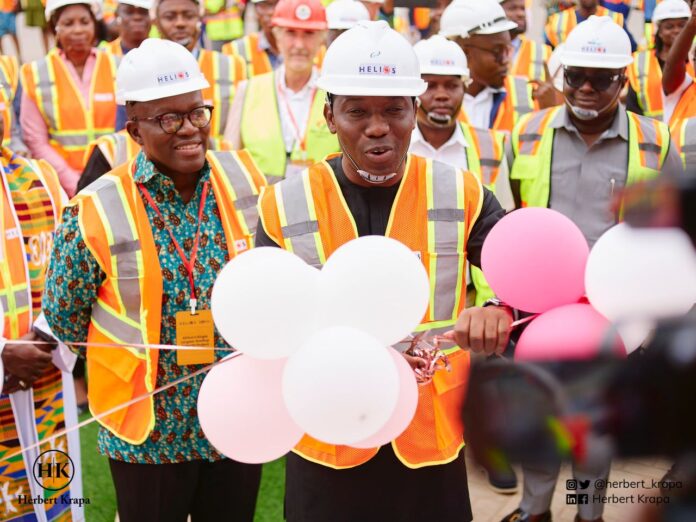The Minister of State at the Ministry of Energy, Herbert Krapa, has commissioned Africa’s single largest rooftop photovoltaic solar plant that produces 16.8 megawatts of electricity at the Tema Free Zones Enclave.
Mr Krapa who was spotted wearing protective gear, climbed the three-storey high roof top to inspect the panels and also turned on the switch for the $17 million which covers project to commence provision of electricity.
He commended owners, Helios Solar Energy, a subsidiary of LMI Holdings putting the project together and helping government achieve its overall all target of increasing renewable energy in the provision of electricity.
It was financed by the International Finance Corporation (IFC) of the IMF Group covers an area of 100,000 square metres. The construction, connection and installation of the entire project were executed by Ghanaian engineers and technicians.
Owned by it is owned by Helios Solar Energy, a subsidiary of LMI Holdings, the panels are mounted on the roof of Mega Warehouse The construction, connection and installation of the entire project were executed by Ghanaian engineers and technicians.
Mr Krapa gave the assurance that government would continue to provide the enabling environment and policies for more private sector provision of renewable energy.
He said it was significant because it underscored the power of the private sector to contribute to government’s agenda in bringing growth, prosperity and development to the people and that apart from enhancing electricity supply, it would lead to the reduction of C02 emissions.
He said government could provide some funding but the biggest funding must by all means come from the private sector and that the project signaled a lead and tells the private sector the role that it has to play to support government in achieving the vision of 10 per cent renewable energy sources in the nation’s mix by 2030.
Mr Krapa said the project signifies a clear indication that there were more private sector players across the globe who are interested in helping government to meet its target.
These players, he added, would take a cue from the private sector and reach out and partner government to ensure that together we are able to achieve that vision.
Mr Krapa indicated that the project was also very important for the socio-economic impact that it has on the economy, noting that “By this project you are creating greener and sustainable jobs for our people and helping us to meet our nationally determined contributions under the Paris Agreement.”
He indicated that the project was also helping to introduce skills and technology to the young engineers whom they have trained as part of the development and maintenance and that its rippling effect on the development of the solar energy industry in Ghana was enormous.
He added that it would also contribute significantly to helping improve standard of living of the people and that “government is also very equally proud of you for that contribution.”
Regarding its impact on industry, Mr Krapa said, it would contribute to reduced cost of power in industry and position the manufacturing sector in a very competitive stead, adding that over time solar energy leads to reduced cost in the mix.
“You are helping to power industry and you are helping industry to also meet their green credentials,” he said.
Vision
Mr Krapa said the project feeds into government’s overall vision for the power sector and more specifically the renewable energy vision.
“Government is alive to its ethical responsibility that we have to help protect the planet, we have come up with a national energy transition framework which we did consulting across all 16 regions and have concluded that by 2060 we should have walked a net zero pathway,” he added.
He announced that government had modeled that National Energy Transition Framework into an investment plan which the president launched on the sidelines of the UN General Assembly last year.
He said significant number of projects are required to be executed for this implementation plan to see the light of day.

